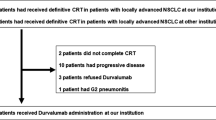Abstract
Objective
The aim of our study was to investigate the value of CT/CT image fusion radiation treatment planning in non-small cell lung cancer (NSCLC) and the impact on V20 and radiation pneumonitis (RP).
Methods
Patients who were pathologically or cytologically diagnosed of stage IIIA and IIIB NSCLC were treated with three-dimensional conformal radiation therapy (4000 cGy). Forty patients got at least 25% tumor reduction were randomly divided into two groups: group A of regular shrink field radiotherapy (20 cases) and group B of CT/CT image fused shrink field radiotherapy (20 cases). Dosage reached 6600 cGy. Clinical data, V20 and RP were observed within 3 months after radiotherapy. Statistical analysis was conducted for the NSCLC patients.
Results
22.5% (9/40) patients got RP during follow-up. Group A accounted for 6 cases (30%), and group B had 3 cases (15%). There was no marked difference between the two groups (P = 0.256), univariate analysis revealed that the IV20 of A and B groups, and IV20 and CV20 of all patients were statistically related to the incidence of RP (P < 0.05). With Wilcoxon method assay, the ipsilateral lung V20 and contralateral lung V20 had statistical significance between the two groups (P < 0.05).
Conclusion
The CT/CT image infusion treatment planning could increase the radical dosage with better tumor control probability but won’t increase adverse reaction.
Similar content being viewed by others
References
Nagata Y, Negoro Y, Aoki T, et al. Clinical outcomes of 3D conformal hypofractionated single high-dose radiotherapy for one or two lung tumors using a stereotactic body frame. Int J Radiat Onol Biol Phys, 2002, 52: 1041–1046.
Sim S, Rosenzweig KE, Schindelheim R, et al. Induction chemotherapy plus three-dimensional conformal radiation therapy in the definitive treatment of locally advanced non-small-cell lung cancer. Int J Radiat Oncol Biol Phys, 2001, 51: 660–665.
Tsujino K, Hirota S, Endo M, et al. Predictive value of dose-volume histogram parameters for predicting radiation pneumonitis after concurrent chemoradiation for lung cancer. Int J Radiat Oncol Biol Phys, 2003, 55: 110–115.
Zhu XZ, Wang LH, Wang YJ, et al. Risk factors for radiation pneumonitis in stage III non-small-cell lung cancer treated with three-dimensional conformal radiotherapy. Chin J Radiat Oncol (Chinese), 2007, 16: 421–426.
Hernando ML, Marks LB, Bentel GC, et al. Radiation induced pulmonary toxicity: a dose volume histogram analysis in 201 patients with lung cancer. Int J Radiat Oncol Biol Phys, 2001, 51: 650–659.
Yorke ED, Jackson A, Rosenzweig KE, et al. Correlation of dosimetric factors and radiation pneumonitis for non-small-cell lung cancer patients in a recently completed dose escalation study. Int J Radiat Oncol Biol Phys, 2005, 63: 672–682.
Graham MV, Purdy JA, Emami B, et al. Clinical dose-volume histogram analysis for peneumonitis after 3D treatment for non-small cell lung cancer (NSCLC). Int J Radiat Oncol Biol Phys, 1999, 45: 323–329.
Yang LQ, Wu LP, Chen LJ, et al. Value of V20 and V30 parameters for predicting acute radiation lung toxicity after 3D radiotherapy for lung cancer. Chin J Cancer Prev Treat (Chinese), 2008, 15: 280–282.
Tyldesley S, Boyd C, Schulze K, et al. Estimaring the need for radiatherapy for lung cancer: an evidence-basde, epidemiologic approch. Int J Radiat Oncol Biol Phys, 2001, 49: 937–985.
Kong FM, Ten Haken RK, Schipper MJ, et al. High-dose radiation improved local tumor control and overall survival in patients with inoperable/ unresectable non-small-cell lung cancer: long-term results of a radiation dose escalation study. Int J Radiat Oncol Biol Phys, 2005, 63: 324–333.
Rosenzweig KE, Sim SE, Mychalczak B, et al. Elective nodal irradiation in the treatment of non-small-cell lung cancer with three-dimensional conformal radiation therapy. Int J Radiat Oncol Biol Phys, 2001, 50: 681–685.
Ge W, Yuan GJ, Li CH, et al. CT image fusion in the evaluation of radiation treatment planning for non-small cell lung cancer. Chinese-German J Clin Oncol, 2008, 7: 315–318.
Yin WB, Gu XZ. Radiation therapy oncology (fourth edition). Beijing: China Union Medical University Press, 2008. 578.
Hou YL, Ye M, Wu XD, et al. Three-dimensional conformal radiotherapy in the radical treatment of non-small cell lung cancer. Chin Clin Oncol (Chinese), 2008, 13: 232–234.
Li CH, Ge W, Lin XL, et al. Application of CT/CT image fusion in evaluation of radiotherapy planning for non-small cell lung cancer. Med J Wuhan Univ (Chinese), 2007, 28: 638–641.
Author information
Authors and Affiliations
Corresponding author
Rights and permissions
About this article
Cite this article
Liu, L., Zhang, J., Li, C. et al. Study of the impact of CT/CT image fusion radiotherapy on V20 and radiation pneumonitis of non-small cell lung cancer. Chin. -Ger. J. Clin. Oncol. 11, 72–75 (2012). https://doi.org/10.1007/s10330-011-0896-2
Received:
Revised:
Accepted:
Published:
Issue Date:
DOI: https://doi.org/10.1007/s10330-011-0896-2




